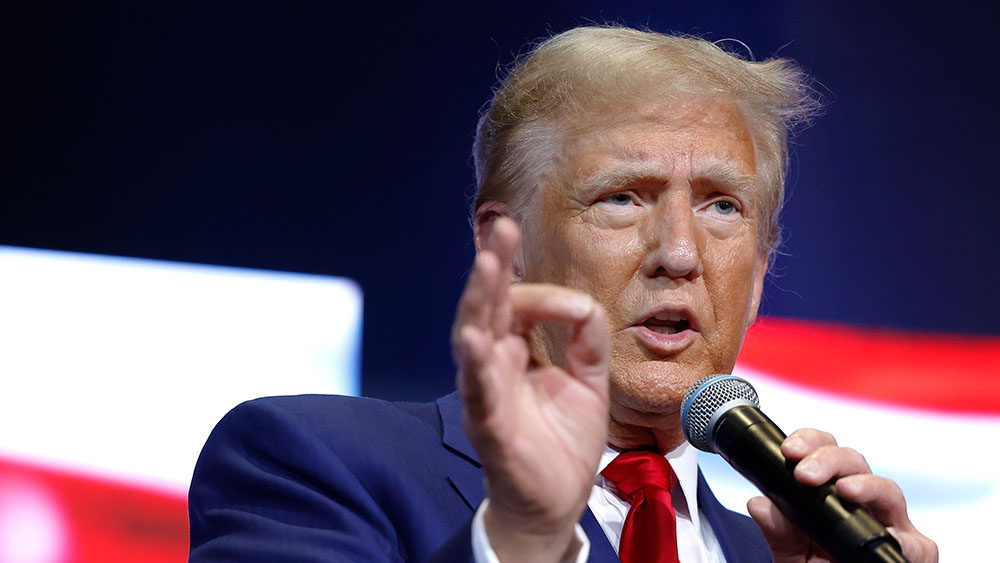- President Donald Trump criticizes the Federal Reserve and Chair Jerome Powell on Truth Social for allegedly creating and failing to address the current inflation crisis.
- Trump’s strategy to combat inflation includes unleashing American energy production, deregulation, rebalancing international trade and reviving American manufacturing.
- The Fed decides to hold interest rates steady, signaling a more hawkish approach amid economic uncertainties, which draws criticism from Trump.
- Trump’s critique of the Fed reflects a broader conservative concern about the central bank’s role in shaping the economy and its focus on social and environmental issues.
In a fiery statement on Truth Social, President Donald Trump launched a scathing critique of the Federal Reserve and Chair Jerome Powell, accusing the central bank of failing to address the inflation crisis it allegedly created. The president’s remarks came just hours after the Fed held interest rates steady, signaling a cautious approach to monetary policy amid lingering economic uncertainties.
Trump’s bold declaration marks a significant escalation in his ongoing battle with the Fed, a conflict that has deep roots in his first term and reflects broader conservative concerns about the central bank’s role in shaping the nation’s economic future.
Trump’s plan to tackle inflation: Unleashing American energy and manufacturing
In his Truth Social post, Trump outlined his strategy to combat inflation, vowing to “unleash American Energy production, slash Regulation, rebalance International Trade and reignite American Manufacturing.” He went further, promising to not only stop inflation but to restore America’s financial and geopolitical power.
“Because Jay Powell and the Fed failed to stop the problem they created with Inflation, I will do it,” Trump wrote. “But I will do much more than stopping Inflation, I will make our country financially, and otherwise, powerful again!”
Trump’s emphasis on energy production and deregulation aligns with long-standing conservative principles that prioritize economic growth through free-market policies. His critique of the Fed’s focus on “DEI, gender ideology, ‘green’ energy and fake climate change” reflects a broader skepticism among conservatives about the central bank’s involvement in social and environmental issues.
“If the Fed had spent less time on DEI, gender ideology, ‘green’ energy and fake climate change, Inflation would never have been a problem,” Trump asserted. “Instead, we suffered from the worst Inflation in the History of our Country!”
A hawkish Fed and a cautious Powell
The Fed’s decision to hold rates steady at 4.25%-4.5% was widely anticipated, but its removal of language suggesting progress toward its 2% inflation target signaled a more hawkish stance. This cautious approach has drawn criticism from Trump, who has long argued that the Fed’s policies have stifled economic growth.
At a press conference following the decision, Powell emphasized the need for patience, stating, “We do not need to be in a hurry to adjust our policy stance.” He also declined to comment on Trump’s recent demand for rate cuts, saying, “It is not appropriate for me to do so.”
Powell’s measured tone underscores the delicate balance the Fed must strike between addressing inflation and supporting economic growth. However, Trump’s aggressive rhetoric suggests that the central bank’s independence may face renewed challenges under his administration.
A familiar battle
This is not the first time Trump has clashed with the Fed. During his first term, he repeatedly criticized Powell for raising interest rates, accusing the central bank of undermining his efforts to stimulate economic growth. The tension between the two men reflects a broader ideological divide over the role of monetary policy in shaping the economy.
Conservatives have long argued that the Fed’s focus on social and environmental issues distracts from its core mission of maintaining price stability and fostering full employment. Trump’s latest critique echoes these concerns, accusing the Fed of neglecting its responsibilities while pursuing a progressive agenda.
The stakes are high as Trump’s administration prepares to implement sweeping changes to trade, immigration and fiscal policy. Powell acknowledged the potential impact of these policies, stating, “We need to let those policies be articulated before we can make a plausible assessment.”
A test of Fed independence
As Trump and the Fed prepare for what could be a protracted battle, the central bank’s independence will face its greatest test in decades. Powell has vowed to remain focused on the Fed’s mandate, stating, “The public should be confident that we will continue to do our work as we always have, focusing on using our tools to achieve our goals.”
However, Trump’s determination to reshape the economy on his terms suggests that the Fed’s cautious approach may not be enough to satisfy the president or his supporters. With inflation still above target and economic growth showing signs of resilience, the coming months will be critical in determining the direction of monetary policy—and the future of the Fed itself.
In the meantime, Trump’s bold promises to unleash American energy, slash regulation and reignite manufacturing offer a clear vision of his economic agenda. Whether the Fed will align with that vision—or resist it—remains to be seen.
One thing is certain: the battle between Trump and the Fed is far from over, and its outcome will have profound implications for the American economy and the conservative movement.
Sources include:
